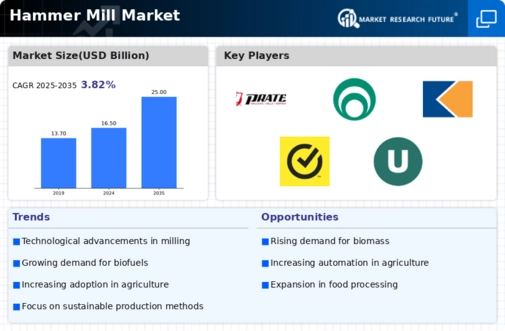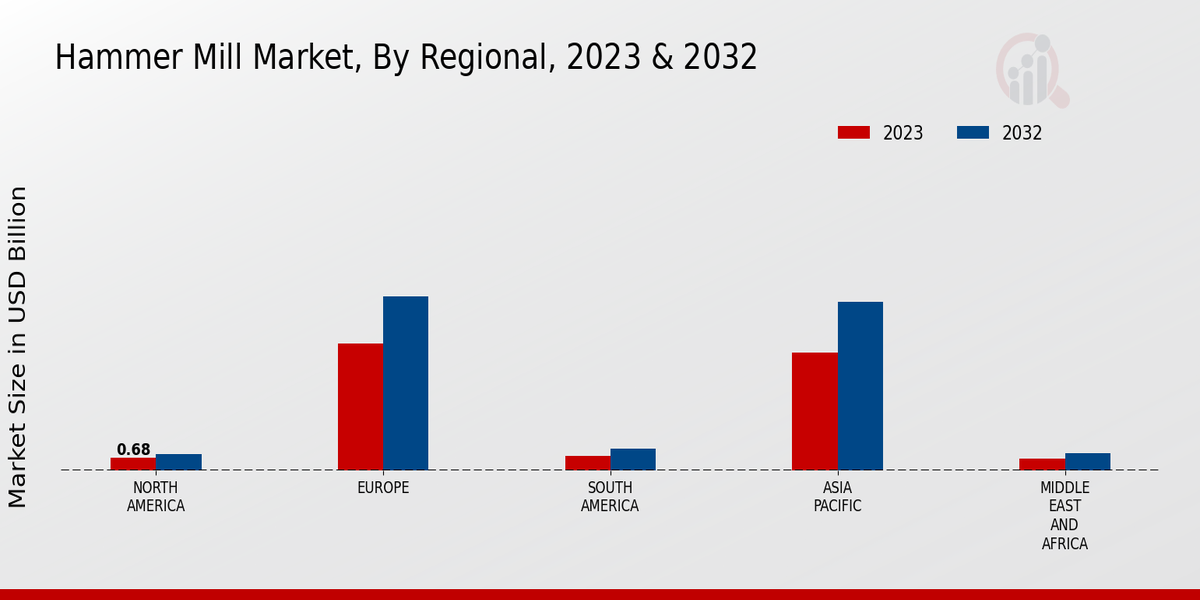Market Growth Projections
The Global Hammer Mill Market Industry is poised for substantial growth, with projections indicating a market size of 16.5 USD Billion in 2024 and an anticipated increase to 25.0 USD Billion by 2035. This growth trajectory suggests a compound annual growth rate of 3.82% from 2025 to 2035. Such figures highlight the increasing reliance on hammer mills across various sectors, including agriculture, food processing, and biomass energy. The market's expansion reflects broader trends in industrial processing and sustainability, underscoring the vital role of hammer mills in meeting global demands.
Rising Biomass Utilization
The Global Hammer Mill Market Industry is witnessing a notable increase in biomass utilization, driven by the growing emphasis on renewable energy sources. Hammer mills are integral in processing biomass materials for biofuel production, which aligns with global sustainability goals. As countries aim to reduce carbon emissions and transition to greener energy alternatives, the demand for efficient biomass processing solutions is likely to escalate. This shift could contribute to the market's growth, with projections indicating a rise to 25.0 USD Billion by 2035. The increasing focus on renewable energy underscores the importance of hammer mills in the Global Hammer Mill Market Industry.
Technological Advancements
Technological innovations play a pivotal role in the expansion of the Global Hammer Mill Market Industry. The introduction of advanced features such as variable speed control, energy-efficient motors, and automated systems enhances the performance and efficiency of hammer mills. These advancements not only improve processing capabilities but also reduce operational costs for users. As industries increasingly prioritize sustainability and efficiency, the demand for technologically advanced hammer mills is expected to rise. This trend indicates a potential shift in market dynamics, with companies investing in research and development to meet evolving consumer needs within the Global Hammer Mill Market Industry.
Growing Demand in Agriculture
The Global Hammer Mill Market Industry is experiencing a surge in demand driven by the agricultural sector. Hammer mills are essential for processing grains, animal feed, and biomass, which are critical for food production. As the global population continues to rise, the need for efficient food processing solutions becomes increasingly paramount. In 2024, the market is projected to reach 16.5 USD Billion, reflecting the agricultural industry's reliance on hammer mills for enhancing productivity. This trend is likely to persist as farmers seek innovative technologies to optimize their operations, thereby propelling the growth of the Global Hammer Mill Market Industry.
Expansion of Food Processing Sector
The food processing sector is a significant driver of the Global Hammer Mill Market Industry, as these machines are essential for grinding and milling various food products. With the increasing consumer demand for processed foods, manufacturers are investing in advanced hammer mills to enhance production efficiency and product quality. The sector's growth is expected to contribute to a compound annual growth rate of 3.82% from 2025 to 2035. This trend suggests that as food processing continues to expand globally, the reliance on hammer mills will intensify, further solidifying their role in the Global Hammer Mill Market Industry.
Increased Focus on Animal Feed Production
The Global Hammer Mill Market Industry is significantly influenced by the rising demand for animal feed production. As livestock farming expands to meet the growing protein consumption worldwide, the need for efficient feed processing solutions becomes critical. Hammer mills are widely used to produce high-quality animal feed, which is essential for livestock health and productivity. This trend is likely to drive market growth, as producers seek to enhance feed quality and reduce costs. The emphasis on optimizing animal feed production aligns with the overall growth trajectory of the Global Hammer Mill Market Industry.

















Leave a Comment